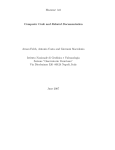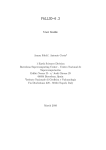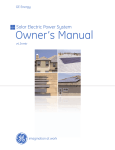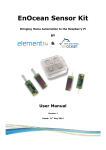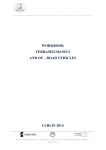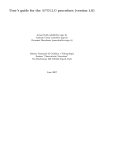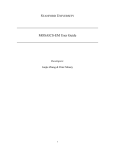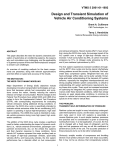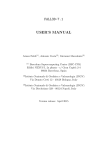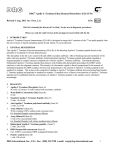Download Fall3d 5.0 Giovanni Macedonio, Arnau Folch and Antonio Costa
Transcript
Fall3d 5.0 Computer Code and Related Doumentation Giovanni Macedonio, Arnau Folch and Antonio Costa Istituto Nazionale di Geofisica e Vulcanologia Sezione ”Osservatorio Vesuviano” Via Diocleziano 326 -80124 Napoli, Italy June 2007 2 FALL3D 5.0 USER MANUAL Contents 1 Introduction 1.1 Governing equation . . . . . . . . . . . . . . . . . . . . . . . . . . . . . . . . . . . . . . . . 1.2 Parameterisation of the Eddy Diffusivity Tensor . . . . . . . . . . . . . . . . . . . . . . . 1.3 Settling velocity models . . . . . . . . . . . . . . . . . . . . . . . . . . . . . . . . . . . . . 3 3 3 4 2 Program setup 2.1 Installation . . . . . . . . . . . . . . . . . . . . . . . . . . . . . . . . . . . . . . . . . . . . 2.2 Folder structure . . . . . . . . . . . . . . . . . . . . . . . . . . . . . . . . . . . . . . . . . . 2.3 Program run . . . . . . . . . . . . . . . . . . . . . . . . . . . . . . . . . . . . . . . . . . . 5 5 6 6 3 The Fall3d 5.0 input files 3.1 The control file FileInp . . . . 3.1.1 BLOCK TIME UTC . . 3.1.2 BLOCK FALL3D . . . . 3.2 The source file FileSrc . . . . 3.3 The granulometry file FileGrn 3.4 The source file FileDbs . . . . . . . . . . 7 7 7 7 8 9 9 4 The Fall3d 5.0 output files 4.1 The list file FileLst . . . . . . . . . . . . . . . . . . . . . . . . . . . . . . . . . . . . . . . 4.2 The results file FileRes . . . . . . . . . . . . . . . . . . . . . . . . . . . . . . . . . . . . . 9 9 9 . . . . . . . . . . . . . . . . . . . . . . . . . . . . . . . . . . . . . . . . . . . . . . . . 5 The utility programs 5.1 The program SetGrn . . . . . . . . . . . . 5.1.1 Program execution . . . . . . . . . . . 5.1.2 The GRANULOMETRY block . . . . 5.2 The program SetSrc . . . . . . . . . . . . . 5.2.1 Program execution . . . . . . . . . . . 5.2.2 The SOURCE block . . . . . . . . . . 5.3 The program BuildDbs . . . . . . . . . . . 5.3.1 Program execution . . . . . . . . . . . 5.3.2 The METEO DATABASE block . . . 5.3.3 The meteo data file FileDat . . . . . 5.3.4 The topography file FileTop . . . . . 5.4 The program ModelPostp . . . . . . . . . 5.4.1 Program execution . . . . . . . . . . . 5.4.2 The POSTPROCESS MODELS block 6 References . . . . . . . . . . . . . . . . . . . . . . . . . . . . . . . . . . . . . . . . . . . . . . . . . . . . . . . . . . . . . . . . . . . . . . . . . . . . . . . . . . . . . . . . . . . . . . . . . . . . . . . . . . . . . . . . . . . . . . . . . . . . . . . . . . . . . . . . . . . . . . . . . . . . . . . . . . . . . . . . . . . . . . . . . . . . . . . . . . . . . . . . . . . . . . . . . . . . . . . . . . . . . . . . . . . . . . . . . . . . . . . . . . . . . . . . . . . . . . . . . . . . . . . . . . . . . . . . . . . . . . . . . . . . . . . . . . . . . . . . . . . . . . . . . . . . . . . . . . . . . . . . . . . . . . . . . . . . . . . . . . . . . . . . . . . . . . . . . . . . . . . . . . . . . . . . . . . . . . . . . . . . . . . . . . . . . . . . . . . . . . . . . . . . . . . . . . . . . . . . . . . . . . . . . . . . . . . . . . . . . . . . . . . . . . . . . . . . . . . . . . . . . . . . . . . . . . . . . . . . . . . . . . . . . . . . . . . . . . . . . . . . . . . . . . . . . . 9 9 10 10 11 11 12 13 13 13 14 14 15 15 16 18 3 FALL3D 5.0 USER MANUAL 1 Introduction Fall3d 5.0 is a code written in FORTRAN90 which circumvents most of the simplifications behind the simpler volcanic ash fallout models. The model solves the time-dependent 3D advection-diffusionsedimentation equation by means of a finite differences explicit scheme using a regular mesh. It uses the gradient transport theory to evaluate the atmospheric turbulent diffusion within and above the Atmospheric Boundary Layer (ABL) and experimental fits for the particle settling velocities, in addition to values from a dataset that contains full 3D prognostic wind field, source term, and topography. The model can, consequently, be used to forecast either ash concentration in the atmosphere or ash loading on the ground. 1.1 Governing equation The non-conservative form of continuity equation written in a generalised coordinate system (X, Y, Z) is: ∂C ∂C ∂C ∂Vsj ∂C +U +V + (W − Vsj ) = −C∇ · U + C ∂t ∂X ∂Y ∂Z ∂Z ∂C/ρ∗ ∂C/ρ∗ ∂C/ρ∗ ∂ ∂ ∂ ρ∗ K X + ρ∗ K Y + ρ∗ K Z + S∗ ∂X ∂X ∂Y ∂Y ∂Z ∂Z (1) where C is the scaled average concentration, (U, V, W ) are the scaled wind speeds, KX , KY and KZ are the diagonal scaled diffusion coefficients, ρ∗ the scaled atmospheric density and S∗ is the source term in the generalized coordinate system. Considering as a frame of reference a simple terrain-following coordinate system where the horizontal coordinates remain unchanged with respect to the Cartesian (x = X, y = Y, z → Z), the scaling factors are those reported in Table 1. Equation (1) is solved for each particle velocity class independently, i.e. assuming no interaction between particles belonging to different classes during the transport process. For a detailed description see Costa et al. (2005). 1.2 Parameterisation of the Eddy Diffusivity Tensor In order to solve equation (1) it is necessary to evaluate the vertical and horizontal diffusion coefficients. Inside the atmospheric surface layer, the Monin-Obukhov similarity theory estimates the vertical turbulent diffusivity Kz in terms of the friction velocity u∗ , and the Monin-Obukhov length L: Kz = κzu∗ φh (2) where κ is the von Karman constant (κ = 0.4), z is the distance from the ground, and φh is the atmospheric stability function (e.g. Jacobson, 1999). Above the surface layer, the original form of the Monin-Obukhov similarity theory is no longer valid. In order to extend this theory to the entire boundary layer (z/h < 1) an evaluation of the Atmospheric Boundary Layer (ABL) height h is required. For this purpose, Fall3d 5.0 uses a simple parameterisation valid on the entire ABL (Ulke, 2000): −1 hz z 1 + 9.2 κu∗ z 1 − h Lh Kz = 1/2 z h z κu∗ z 1 − 1 − 13 h Lh h/L ≥ 0 stable (3) h/L ≤ 0 unstable Note that in the neutral case (L → ∞) both expressions coincide. Finally, in the free atmosphere above the ABL (z/h > 1), Kz is considered a function of the local vertical wind gradient, a characteristic length scale lc , and a stability function Fc depending on the Richardson number Ri: ∂V Fc (Ri) (4) Kz = lc2 ∂z 4 FALL3D 5.0 USER MANUAL For lc and Fc the model adopts the relationship used by the CAM3 model (Collins et al., 2004) of the National Center for Atmospheric Research (NCAR): lc = Fc (Ri) = 1 1 + κz λc −1 1 1 + 10Ri(1 + 8Ri) √1 − 18Ri (5) stable (Ri > 0) unstable (6) (Ri < 0) where λc is the so-called asymptotic length scale (λc ≈ 30m) while the Richardson number is calculated g ∂θv /∂z (with θ being virtual potential temperature). as Ri = θv |∂V /∂z|2 On the other hand, for the horizontal eddy diffusivity KH = Kx = Ky Fall3d 5.0 assumes a large eddy parameterisation (Azad and Kitada, 1998): v " u 2 2 2 # u ∂vx 1 ∂v ∂v ∂v x y y KH = α∆x∆y t (7) + + + ∂y ∂x 2 ∂x ∂y where α is a dimensionless constant of the order of unity that ranges from 0.1 to 5 depending on the size of the domain, and ∆x and ∆y are the horizontal grid spacings (commonly α = 0.5). The model permits also to use other K−parametisations such as a constant value for Kz , a constant value for KH or to estimate KH using a Smagorinsky model as that used by RAMS model (for ∆z/∆ ≪ 1 Pielke et al., 1992): v " u 2 2 2 # u ∂vx ∂v ∂v ∂v y y x KH = R max Kmh ; (CSH ∆)2 t +2 + + (8) ∂y ∂x ∂x ∂y Kmh = 0.075KA∆4/3 p where ∆ = ∆x ∆y , CSH is a dimensionless constant ranging from 0.135 to 0.32, KA is a user defined parameter close to one, and R ≃ 3. 1.3 Settling velocity models Settling velocity fits contemplated by Fall3d 5.0 include: • ARASTOOPOUR (Arastoopour et al., 1982) vs = Cd = s 4gdρp 3Cd ρa 24 Re(1 + 15Re0.687) 0.44 (9) Re ≤ 103 Re > 103 (10) where ρa and ρp stand, respectivelly, for the air and particle densities, d is the particle diameter, Re is the Reynolds number and Cd is a drag coefficient. • GANSER (Ganser , 1993) vs = s 4gdρp 3Cd ρa o 0.4305K2 24 n 0.6567 + C = 1 + 0.1118 [Re (K K )] d 1 2 0.4305 ReK1 1+ ReK1 K2 K1 = 3/(1 + 2ψ −0.5 ) 0.5743 K = 101.84148(−Logψ) 2 where ψ is the particle sphericity (=1 for spherical particles). (11) (12) 5 FALL3D 5.0 USER MANUAL Parameter Coordinates Velocities Diffusion Coefficients Concentration Density Source Term Scaling X = x Y = y Z = z − h(x, y) U = ux V = uy W = uz J −1 Vsj = vsj J −1 KX = Kx KY = Ky KZ = Kz J −2 C = cJ ρ∗ = ρJ S∗ = SJ Table 1: Summary of the scaling factors for the terrain-following domain coordinate system (x = X, y = Y, z → Z). J indicates the Jacobian of the coordinate system transformation. • WILSON (Wilson and Wang , 1979) vs = s 4gdρp 3Cd ρa p 24 −0.828 + 2 1.07 − φ Re φ 1 − Cd (Re = 100) Cd = (Re − 1000) + 1 900 1 (13) Re ≤ 102 102 ≤ Re ≤ 103 (14) Re ≥ 103 where φ is the aspect ratio (b + c)/2a (a, b, c ellipsoidal semi-axes). • DELLINO (Dellino et al., 2005). vs = 0.5206 1.2065µ 3 d (ρp − ρa )ρa Ψ1.6 /µ2 dρa where µ is the air viscosity and Ψ is the shape factor (sphericity to circularity ratio). (15) FALL3D 5.0 USER MANUAL 2 6 Program setup 2.1 Installation • On a Windows OS download and decompress the file Fall3d-5.0.tar.gz on your selected directory. The Fall3d-5.0.tar file already contains Windows executables for Fall3d 5.0 and the rest of included utility programs. It is not strictly necessary to have a FORTRAN90 compiler. The untaring of Fall3d-5.0.tar will create the folders described in the Table 2. • On a Unix/Linux/Mac X operating system: 1. Decompress and then untar the file Fall3d-5.0.tar issuing the command “tar xvf Fall3d-5.0.tar”. This will generate directory Fall3d-5.0 (see Table 2). 2. Compile the program Fall3d 5.0 . Enter the directory Fall3d-5.0/Sources, then issue the command “make” to produce the executable Fall3d.exe. You can edit the Makefile to select your favourite compiler. After compilation you may issue the command “make clean” to remove unneeded files. If you are not going to run on a Windows platform you can also delete the executable Fall3d.win.exe. 3. Compile the (optional) utility program SetGrn . Enter the directory Fall3d-5.0/Utilities/SetGrn/Sources, then issue the command “make” to produce the executable SerGrn.exe. You can edit the Makefile to select your favourite compiler. After compilation you may issue the command “make clean” to remove unneeded files. If you are not going to run on a Windows platform you can also delete the executable SetGrn.win.exe. 4. Compile the (optional) utility program SetSrc . Enter the directory Fall3-3.0/Utilities/SetSrc/Sources, then issue the command “make” to produce the executable SerSrc.exe. You can edit the Makefile to select your favourite compiler. After compilation you may issue the command “make clean” to remove unneeded files. If you are not going to run on a Windows platform you can also delete the executable SetSrc.win.exe. 5. Compile the (optional) utility program BuildDbs . Enter the directory Fall3-3.0/Utilities/BuildDbs/Sources, then issue the command “make” to produce the executable SerSrc.exe. You can edit the Makefile to select your favourite compiler. After compilation you may issue the command “make clean” to remove unneeded files. If you are not going to run on a Windows platform you can also delete the executable BuildDbs.win.exe. 6. Compile the (optional) utility program ModelPostp . Enter the directory Fazmap-3.0/Utilities/ModelPostp/Sources, then issue the command “make” to produce the executable ModelPostp.exe. You can edit the Makefile to select your favourite compiler. After compilation you may issue the command “make clean” to remove unneeded files. If you are not going to run on a Windows platform you can also delete the executable ModelPostp.win.exe. 2.2 Folder structure Table 2 shows the folder structure. The directory Fall3d-5.0/Sources contains the Fall3d 5.0 source files, the directory Fall3d-5.0/Utilities contains the programs SetGrn , SetSrc , BuildDbs , and ModelPostp and, finally, the directory Fall3d-5.0/Runs contains the runs, one within each own folder. An example run named “Example” is provided with the installation. 2.3 Program run Fall3d 5.0 can be launched typing “Fall3d.exe FileInp FileSrc FileGrn FileDbs FileLst FileRes” (on a Unix/Linux/Mac X OS) or “Fall3d.win.exe FileInp FileSrc FileGrn FileDbs FileLst FileRes” (on a Windows OS), where • FileInp: Name (including path) of the control input file (see section 3.1). • FileSrc: Name (including path) of the source input file (see section 3.2). 7 FALL3D 5.0 USER MANUAL Table 2: Default directory structure. Fall3d-5.0 Sources Utilities SetGrn SetSrc BuildDbs ModelPostp Runs Example .... • FileGrn: Name (including path) of the granulometry input file (see section 3.3). • FileDbs: Name (including path) of the meteo data input file (see section 3.4). • FileLst: Name (including path) of the output list file (see section 4.1). • FileInp: Name (including path) of the Fall3d 5.0 results file (see section 4.2). Note that filenames (and locations) are passed as a program call argument. It is highly recomended to launch Fall3d 5.0 through the script files included in the distribution. • On a Windows OS enter the folder Fall3d-5.0, edit the script Script-Fall3d-Win.bat to change the “problemname” variable and launch the script. • On a Mac X/Unix/Linux OS enter the folder Fall3d-5.0, edit the script Script-Fall3d-Unix to change the “problemname” variable and launch the script. NOTE: To create a new run you can simply create a new folder, copy the control input file of the example (Example.inp) and modifiy the script line which defines the “problemname” variable. FALL3D 5.0 USER MANUAL 8 The Fall3d 5.0 input files 3 3.1 The control file FileInp The Fall3d 5.0 control file is passed to the program as a call argument. This file is made up with a set of blocks that define all the computational and physical parameters needed by the dispersion model (Table 3 shows an example of control file). Parameters within a block are listed one per record, in arbitrary order, and can optionally be followed by one or more blank spaces and a comment. A detailed description of each record is given below. Real numbers can be expressed following the FORTRAN notation (e.g., 12e7 = 12 × 107 ). 3.1.1 BLOCK TIME UTC This block of data defines variables related to time. • YEAR: Simulation year. • MONTH: Simulation month (1-12). • DAY: Simulation day (1-31). • RUN START (HOURS AFTER 00): Run start hour (after 0000UTC). • ERUPTION END (HOURS AFTER 00) : Eruption end hour (after 0000UTC). If the SetSrc program is used to generate the source term, this is the time instant at which source is switched off. • RUN END (HOURS AFTER 00): Run end hour (after 0000UTC). Note that, in general, a run should continue even when the source term is switched off (i.e. when the eruption has stop) in order to give time for the remaining airborne particles to fall. 3.1.2 BLOCK FALL3D This block of data defines the rest of variables needed by the program. • ZLAYER (M): Heights (in m) of the z-layers in terrain following coordinates, i.e. above the vent. It is not necessary to specify the number of vertical layers since it is automatically calculated by the program. • TERMINAL VELOCITY MODEL: Type of terminal settling velocity model. Possibilities are ARASTOOPOUR (Arastoopour et al., 1982), GANSER (Ganser , 1993), WILSON (Wilson and Wang , 1979) and DELLINO (Dellino et al., 2005). • TERMINAL VELOCITY MODEL FACTOR: Model dependent factor. For ARASTOOPOUR it is not used. For GANSER it is the sphericity ψ (see 12). For WILSON it is the aspect ratio φ (see 14). Finally, for DELLINO it is the shape factor Ψ (see 15). • VERTICAL TURBULENCE MODEL: Type of model for vertical diffusion. Possibilities are CONSTANT or SIMILARITY. See Costa et al. (2005) for details. • VERTICAL DIFFUSION COEFFICIENT (M2/S): Value of the diffusion coefficient (in m2 /s). Only used if VERTICAL TURBULENCE MODEL = CONSTANT • HORIZONTAL TURBULENCE MODEL: Type of model for horizontal diffusion. Possibilities are CONSTANT, PIELKE, or RAMS. See Costa et al. (2005) for details. • HORIZONTAL DIFFUSION COEFFICIENT (M2/S): Value of the diffusion coefficient (in m2 /s). Only used if HORIZONTAL TURBULENCE MODEL = CONSTANT. • SAFETY FACTOR: Safety factor. This is a factor that multiplies the critical time step. It should be equal or lower than 1.0 (typically 0.8-0.9) to ensure stability. • USE LIMITER METHOD: Flag to indicate the use of limiter. Possibilities are YES or NO. If YES the algoritm uses a limiter method. See Costa et al. (2005) for details. FALL3D 5.0 USER MANUAL 9 Table 3: Sample of the input control file FileInp. TIME UTC YEAR = 2007 MONTH = 03 DAY = 01 RUN START (HOURS AFTER 00) = 0. RUN END (HOURS AFTER 00) = 3. ERUPTION END (HOURS AFTER 00) = 3. RUN END (HOURS AFTER 00) = 6. FALL3D ZLAYER (M) = 0 500 1000 1500 2000 2500 3000 3500 4000 4500 5000 TERMINAL VELOCITY MODEL = GANSER TERMINAL VELOCITY MODEL FACTOR = 0.8 VERTICAL TURBULENCE MODEL = SIMILARITY VERTICAL DIFFUSION COEFFICIENT (M2/S) = 100. HORIZONTAL TURBULENCE MODEL = PIELKE HORIZONTAL DIFFUSION COEFFICIENT (M2/S) = 1000. SAFETY FACTOR = 0.9 USE LIMITER METHOD = yes POSTPROCESS TIME INTERVAL (HOURS) = 2. • POSTPROCESS TIME INTERVAL (HOURS): Time interval to output results (in h). Results are also output at the end of the run. 3.2 The source file FileSrc The Fall3d 5.0 source file is an ASCII file containing the definition of the source term. The source is defined at time intervals during which source values are kept constant. The number, position and values (i.e. Mass Flow Rate) of the source points can, however, vary from one time slice to another. There is no restriction on the number and duration of the time intervals. It allows, in practise, to discretize any type of source term. This file can be created by the utility program SetSrc . The file format is described in Table 4 and the meaning of the used symbols is the following: • itime1: Starting time (in sec after 00UTC) of the time slice. • itime2: End time (in sec after 00UTC) of the time slice. • nsrc: Number of source points (can vary from one interval to another). • nc: Number of granulometric classes. • MFR: Mass flow rate (in kg/s). • x: x-coordinate of the source isrc (UTM coordinates in m). • y: y-coordinate of the source isrc (UTM coordinates in m). • z: z-coordinate of the source isrc (terrain following coordinates in m, i.e. above the vent). • src: P Mass P flow rate (in kg/s) of each granulometric class for this point source. It must be verified that src(isrc, ic) = M F R. 10 FALL3D 5.0 USER MANUAL Table 4: Format of the source file FileSrc. Repeat this block for each time slice . itime1 itime2 nsrc nc MFR x y z src(1,1) ... src(1,nc) ... x y z src(nsrc,1) ... src(nsrc,nc) Table 5: Format of the granulometry file FileGrn. nc diam(1) rho(1) fc(1) ... diam(nc) rho(nc) fc(nc) 3.3 The granulometry file FileGrn The Fall3d 5.0 granulometry file is an ASCII file containing particle densities and granulometric distribution. This file can be created by the utility program SetGrn . The file format is described in Table 5 and the meaning of the used symbols is the following: • nc: Number of granulometric classes. • diam: Class diameter (in mm). • rho: Class density (in kg/m3 ). • fc: Class mass fraction (0-1). If must verify that 3.4 P fc = 1. The source file FileDbs The Fall3d 5.0 DataBase file is a binary file created by the BuildDbs utility program. It contains the meteorological database stored in a direct access binary file. In addition to it, BuildDbs creates also an ASCII file that contains the explanation of each record of the FileDbs. 4 4.1 The Fall3d 5.0 output files The list file FileLst This file contains information concerning the run (summary of input data, run time error messages, CPU time, etc.). 4.2 The results file FileRes This is a binary file with the results from a Fall3d 5.0 run. This file must be processed by the ModelPostp utility to produce “human readeable” files (normally in GRD format). 5 5.1 The utility programs The program SetGrn The granulometric distribution is defined in the granulometry file (see section 3.3). The program SetGrn is an utility that reads the GRANULOMETRY block from the control input file and generates the granulometry FALL3D 5.0 USER MANUAL 11 file assuming that the mass fraction of particles follows either a linear or Gaussian distribution in Φ and that the density of particles varies linearly with Φ. Note that other granulometric distributions different from a linear/Gaussian can also be considered. However, in this case, the Fall3d 5.0 granulometry file can not be generated by SetGrn but must be supplied directly by the user. 5.1.1 Program execution To run SetGrn (see section 2.1 for installation details) simply type “SetGrn.exe FileLog FileInp FileGrn” (on a Unix/Linux/Mac X OS) or “SetGrn.win.exe FileLog FileInp FileGrn” (on a Windows OS) where • FileLog: Name (including path) of the SetGrn output log file. • FileInp: Name (including path) of the control input file that contains the GRANULOMETRY block. Normally this file coincides with the Fall3d 5.0 input file. • FileGrn: Name (including path) of the granulometry file. This is the output from SetGrn that is used later by Fall3d 5.0 as input. Note that filenames are passed as a program call argument. It is highly recomended to launch SetGrn through the script files included in the distribution. • On a Windows OS go to the folder Fall3d-5.0/Utilities/SetGrn, edit the script Script-SetGrn-Win.bat to change the “problemname” variable and launch the script. • On a Mac X/Unix/Linux OS enter the folder Fall3d-5.0/Utilities/SetGrn, edit the script Script-SetGrn-Unix to change the “problemname” variable and launch the script. 5.1.2 The GRANULOMETRY block This block of data (see Table 6) defines the variables needed by SetGrn . Commonly this block is appended to the Fall3d 5.0 control input file. The meaning of each record is the following: • NUMBER OF CLASSES: Number of granulometric classes. • DISTRIBUTION: Type of distribution. It can be LINEAR or GAUSSIAN. • FI MIN: Minimum value of Φ. • FI MAX: Maximum value of Φ. • FI MEAN: Mean value of Φ. Only used if (DISTRIBUTION = GAUSSIAN). • FI DISP: Value of σ in the Gaussian distribution. Only used if (DISTRIBUTION = GAUSSIAN). • FI SLOPE: Slope of the linear distribution. Only used if (DISTRIBUTION = LINEAR). • MINIMUM DENSITY: Minimium value of density (in kg/m3 ) and associated value of Φ. For values of Φ lower than this value (larger particles) density is assumed to be constant and equal to the minimum value. • MAXIMUM DENSITY: Maximum value of density (in kg/m3 ) and associated value of Φ. For values of Φ larger than this value (smaller particles) density is assumed to be constant and equal to the maximum value. 12 FALL3D 5.0 USER MANUAL Table 6: Sample of the SetGrn input file. Normally this block is appended at the end of the input file. GRANULOMETRY NUMBER OF CLASSES = 12 DISTRIBUTION = GAUSSIAN FI MIN = 0 FI MAX = 5 GAUSSIAN DISTRIBUTION FI MEAN = 2.5 FI DISP = 1.5 LINEAR DISTRIBUTION FI SLOPE = 0.5 MINIMUM DENSITY = 1080. -3. MAXIMUM DENSITY = 2300 5. 5.2 The program SetSrc The distribution of sources is defined in a source file (see section 3.2). The program SetSrc is an utility that reads the SOURCE block from the control input file and generates a source file. The source term is constant for a given time interval but there is no limit on the number and duration of the time intervals. It allows, in practise, to discretize any kind of time-dependency (time-dependent mass flow rate, column height, etc.). The program admits three possibilities: point source (mass is released in a single source point), Suzuki distribution (Suzuki , 1983; Pfeiffer et al., 2005), and buoyant plume model (Bursik , 2001). The last option is more elaborated and involves the solution of the 1D radial-averaged plume governing equations that describe the convective region of an eruptive column. These equations are intimately coupled with the wind field which, for small to medium size plumes, may induce a substantial plume bent-over and subsequent variations of plume height and mass release location. For this reason, when this option switched on, the program reads the values of the wind field from a meteorological file, computes the averaged wind direction and solves the plume governing equations for each time interval and particle class accounting for wind. Note that it introduces a time dependence in the source term even when all the eruptive parameters (mass flow rate, class fraction, etc.) are kept constant in time. 5.2.1 Program execution To run SetSrc (see section 2.1 for installation details) simply type “SetSrc.exe FileLog FileInp FileSrc FileGrn FileMet MODEL MESH” (on a Unix/Linux/Mac X OS) or “SetSrc.win.exe FileLog FileInp FileSrc FileGrn FileMet MODEL MESH” (on a Windows OS) where • FileLog: Name (including path) of the SetSrc output log file. • FileInp: Name (including path) of the control input file that contains the SOURCE block. Normally this file coincides with the Fall3d 5.0 input file. • FileSrc: Name (including path) of the source file. This is the output from SetSrc that is used later by Fall3d 5.0 as input. • FileGrn: Name (including path) of the granulometry file (normally generated previously by SetGrn ). • FileMet: Name (including path) of the meteo data file generated by BuildDbs . • MODEL: Flag indicating the name of the model. For Fall3d 5.0 it is always “FALL3D”. • MESH: Flag that indicates if the discrete source points must be interpolated onto a mesh. For Fall3d 5.0 it is always “YES”. Note that filenames are passed as a program call argument. It is highly recomended to launch SetSrc through the script files included in the distribution. 13 FALL3D 5.0 USER MANUAL Table 7: Sample of the SetSrc input file. Normally this block is appended at the end of the Fall3d 5.0 input file. In this example a Suzuki source and two time intervals are assumed. SOURCE X VENT (UTM M) = 500080. Y VENT (UTM M) = 4177690. MASS FLOW RATE (KGS) = 5d4 4d4 SOURCE TYPE = SUZUKI POINT SOURCE HEIGHT ABOVE VENT (M) = 2000. SUZUKI SOURCE HEIGHT ABOVE VENT (M) = 3000. 2800. A = 4. 4. L = 5. 5. PLUME SOURCE EXIT VELOCIY (MS) = 100. EXIT TEMPERATURE (K) = 1073. EXIT VOLATILE FRACTION (IN%) = 0. (One value for each source time interval) (Variables below are used only if SOURCE TYPE = POINT) (Variables below are used only if SOURCE TYPE = SUZUKI) (One value for each source time interval) (One value for each source time interval) (One value for each source time interval) (Variables below are used only if SOURCE TYPE = PLUME) • On a Windows OS go to the folder Fall3d-5.0/Utilities/SetSrc, edit the script Script-SetSrc-Win.bat to change the “problemname” variable and launch the script. • On a Mac X/Unix/Linux OS enter the folder Fall3d-5.0/Utilities/SetSrc, edit the script Script-SetSrc-Unix to change the “problemname” variable and launch the script. 5.2.2 The SOURCE block This block of data (see Table 7) defines the variables needed by SetSrc . Commonly this block is appended to the Fall3d 5.0 control input file. The meaning of each record is the following: • X VENT (UTM M): x-coordinate of the vent (UTM coordinates in m). • Y VENT (UTM M): y-coordinate of the vent (UTM coordinates in m). • MASS FLOW RATE (KGS): Values of the mass flow rate (in kg/s). One value for each time interval. The duration of each time interval is constant and given by RUN START (HOURS AFTER 00) minus ERUPTION END (HOURS AFTER 00) divided by the number of time intervals (automatically computed by the program from the number of values). • SOURCE TYPE: Type of source distribution. Possibilities are POINT, SUZUKI or PLUME. • HEIGHT ABOVE VENT (M): Heights of the plume (in m above the vent). One value for each time interval. • A: Parameter A in the Suzuki distribution. SOURCE TYPE = SUZUKI. One value for each time interval. Used only if • L: Parameter L in the Suzuki distribution. One value for each time interval. Used only if SOURCE TYPE = SUZUKI. • EXIT VELOCIY (MS): Magma exit velocity (in m/s) at the vent. One value for each time interval. Used only if SOURCE TYPE = PLUME. • EXIT TEMPERATURE (K): Magma exit temperature (in o K) at the vent. One value for each time interval. Used only if SOURCE TYPE = PLUME. • EXIT VOLATILE FRACTION (IN%): Magma volatile mass fraction at the vent. One value for each time interval. Used only if SOURCE TYPE = PLUME. FALL3D 5.0 USER MANUAL 5.3 14 The program BuildDbs This program generates the database files for Fall3d 5.0 using as input either a veritcal profile (sounding) plus a topography file (in format GRD) or an output of the meteorological processor CALMET (version 6). The latter option is prefereable because CALMET generates a 3D wind field that accounts for topographic effects and determines values for micrometeorological variables in the Atmospheric Boundary Layer (ABL). In the horizontal, and the database use the same spatial discretization. 5.3.1 Program execution To run BuildDbs (see section 2.1 for installation details) simply type “BuildDbs.exe FileLog FileInp FileDat FileDbs FileLst TypeData FileTop” (on a Unix/Linux/Mac X OS) or “BuildDbs.win.exe FileLog FileInp FileDat FileDbs FileLst TypeData FileTop”(on a Windows OS) where • FileLog: Name (including path) of the BuildDbs output log file. • FileInp: Name (including path) of the control input file that contains the METEO DATABASE block. Normally this file coincides with the Fall3d 5.0 input file. • FileDat: Name (including path) of the meteo data file. This is either the vertical profile file or the binary output from CALMET (version 6) depending on the value of TypeData • FileDbs: Name (including path) of the DataBase file. This is the output from BuildDbs that is used later by Fall3d 5.0 as input. • FileLst: Name (including path) of the DataBase record descriptor file. • TypeData: Flag to indicate the origin of meteorological data. Possibilities are PROFILE or CALMET62. • FileTop: Name (including path) of the GRD topography file. Note that filenames are passed as a program call argument. It is highly recomended to launch BuildDbs through the script files included in the distribution. • On a Windows OS go to the folder Fall3d-5.0/Utilities/BuildDbs, edit the script Script-BuildDbs-Win.bat to change the “problemname” variable and launch the script. • On a Mac X/Unix/Linux OS enter the folder Fall3d-5.0/Utilities/BuildDbs, edit the script Script-BuildDbs-Unix to change the “problemname” variable and launch the script. 5.3.2 The METEO DATABASE block This block of data (see Table 8) defines the variables needed by BuildDbs . Commonly this block is appended to the Fall3d 5.0 control input file. The meaning of each record is the following: • YEAR: Simulation year. • MONTH: Simulation month (1-12). • DAY: Simulation day (1-31). • BEGIN METEO DATA (HOURS AFTER 00): Time (in h after 0000UTC) at which meteorological data start. • END METEO DATA (HOURS AFTER 00): Time (in h after 0000UTC) at which meteorological data ends. The meteo time slice should include the simulation time slice defined by the records RUN START (HOURS AFTER 00) and RUN END (HOURS AFTER 00) of the TIME UTC block. • TIME STEP METEO DATA (MIN): Time step (in min) of the meteo data. • X ORIGIN (UTM M): x-coordinate of the grid (UTM coordinates in m). FALL3D 5.0 USER MANUAL 15 Table 8: Sample of the BuildDbs input file. Normally this block is appended at the end of the Fall3d 5.0 input file. METEO DATABASE YEAR = 2007 MONTH = 03 DAY = 01 BEGIN METEO DATA (HOURS AFTER 00) = 0 END METEO DATA (HOURS AFTER 00) = 6 TIME STEP METEO DATA (MIN) = 60 X ORIGIN (UTM M) = 450000 Y ORIGIN (UTM M) = 4125000 CELL SIZE (KM) = 2.0 NX = 51 NY = 51 Z LAYER (M) = 0. 10. 40. 100. 250. 500. 1000. 2500. 5000. 7500. 10000. • Y ORIGIN (UTM M): y-coordinate of the grid (UTM coordinates in m). • CELL SIZE (KM): Horizontal spatial discretization (in km). • NX: Number of grid cells in the x-direction (for both Fall3d 5.0 and BuildDbs ). • NY: Number of grid cells in the y-direction (for both Fall3d 5.0 and BuildDbs ). • ZLAYER (M): Heights (in m) of the database z-layers. If TypeData is PROFILE then BuildDbs interpolates the measured values of velocity and temperature at these heights. If TypeData is CALMET62 the heights represent the CALMET cell faces. Note that the vertical discretizations of BuildDbs and Fall3d 5.0 can differ. The latter is defined in the record ZLAYER (M) of the FALL3D block. 5.3.3 The meteo data file FileDat If TYPE OF DATA = CALMET this is the (binary) calmet output file. On the contrary, if TYPE OF DATA = PROFILE this is an ASCII file containing the definition of the vertical wind profile. In this case, the file format is described in Table 9 and the meaning of the used symbols is the following: • itime1: Starting time (in sec after 00UTC) of the meteo data time slice. • itime2: End time (in sec after 00UTC) of the meteo data time slice. • nz: Number of vertical layers. • z: Vertical coordinate of the layer (in m, terrain following). • ux: wind x-velocity (in m/s). • uy: wind y-velocity (in m/s). • T: Air temperature (in o C). 5.3.4 The topography file FileTop This is a file in GRD format containing the topography. It is used BuildDbs only when TYPE OF DATA = PROFILE The file format is described in Table 10 and the meaning of the used symbols is the following: • nx: Number of cells in the x-direction. Coincides with the value defined in the NX record of the METEO DATABASE block . 16 FALL3D 5.0 USER MANUAL Table 9: Format of the meteo data file FileDat for the PROFILE case. Repeat this block for each meteo time increment. itime1 itime2 nz z(1) ux(1) ux(1) T(1) ... z(nz) ux(nz) ux(nz) T(nz) Table 10: Format of the topography file FileTop for the PROFILE case. DSAA nx ny xo xf yo yf zmin zmax z(1,1) ... z(1,nx) ... z(ny,1) ... z(ny,nx) • ny: Number of cells in the y-direction. Coincides with the value defined in the NY record of the METEO DATABASE block . • xo: x-coordinate of the grid bottom left corner (UTM coordinates in m). Coincides with the value defined in the X ORIGIN (UTM M) record of the METEO DATABASE block . • xf: x-coordinate of the grid top right corner (UTM coordinates in m). • yo: y-coordinate of the grid bottom left corner (UTM coordinates in m). Coincides with the value defined in the Y ORIGIN (UTM M) record of the METEO DATABASE block . • yf: y-coordinate of the grid top right corner (UTM coordinates in m). • zmin: Minimum value of z in the domain. • zmax: Maximum value of z in the domain. • z: Height (in m) of each grid point. 5.4 The program ModelPostp The program ModelPostp (alias for Model Postprocess) is an optional utility that reads the output binary file of Fall3d 5.0 , calculates some relevant quantities at selected time instants and produces elementary maps in GRD and PS formats. 5.4.1 Program execution To run ModelPostp (see section 2.1 for installation details) simply type “ModelPostp.exe FileLog FileInp FileRes BASERES” (on a Unix/Linux/Mac X OS) or “ModelPostp.win.exe FileLog FileInp FileRes BASERES” (on a Windows OS) where • FileLog: Name (including path) of the ModelPostp output log file. • FileInp: Name (including path) of the control input file that contains the POSTPROCESS MODELS block. Normally this file coincides with the Fall3d 5.0 input file. FALL3D 5.0 USER MANUAL 17 • FileRes: Name (including path) of the Fall3d 5.0 results file. This is the output from Fall3d 5.0 that is used by as input. • BASERES: Path where the ModelPostp output files are dump. Note that filenames are passed as a program call argument. It is highly recomended to launch ModelPostp through the script files included in the distribution. • On a Windows OS go to the folder Fall3d-5.0/Utilities/ModelPostp, edit the script Script-ModelPostp-Win.bat to change the “problemname” variable and launch the script. • On a Mac X/Unix/Linux OS enter the folder Fall3d-5.0/Utilities/ModelPostp, edit the script Script-ModelPostp-Unix to change the “problemname” variable and launch the script. 5.4.2 The POSTPROCESS MODELS block This block of data (see Table 11) defines the variables needed by ModelPostp . Commonly this block is appended to the Fall3d 5.0 control input file. The meaning of each record is the following: • OUTPUT FILES IN GRD FORMAT: Possibilities are YES or NO. If YES, ModelPostp plots files in GRD format. Files in GRD format can be readed directly by several plotting programs like the commercial software GRAPHER. Alternativelly, the user may also generate its own plots using functons from several free packages (e.g. gnuplot in FORTRAN). • OUTPUT FILES IN PS FORMAT: Possibilities are YES or NO. If YES, ModelPostp plots files in PS format. • MAP TOTAL LOAD: Possibilities are YES or NO. If YES ModelPostp plots the total ground load. • UNITS: Units of MAP TOTAL LOAD. It must be KG/M2. • CONTOUR LEVELS: Values of the contour levels for MAP TOTAL LOAD. Only used when OUTPUT FILES IN PS FORMAT is YES. • MAP CLASS LOAD: Possibilities are YES or NO. If YES ModelPostp plots the class ground load. • UNITS: Units of MAP CLASS LOAD. It must be KG/M2. • CONTOUR LEVELS: Values of the contour levels for MAP CLASS LOAD. Only used when OUTPUT FILES IN PS FORMAT is YES. • MAP DEPOSIT THICKNESS: Possibilities are YES or NO. If YES ModelPostp plots total deposit thickness. • UNITS: Units of MAP DEPOSIT THICKNESS. Possibilities are MM (for mm), CM (for cm), and M (for m). • COMPACTATION FACTOR: Deposit compactation factor. • CONTOUR LEVELS: Values of the contour levels for MAP DEPOSIT THICKNESS. Only used when OUTPUT FILES IN PS FORMAT is YES. • MAP TOTAL CONCENTRATION: Possibilities are YES or NO. If YES ModelPostp plots the total concentration at certain z-levels. • UNITS: Units of MAP TOTAL CONCENTRATION. It must be KG/M3. • Z CUTS (M): z-coordinates of the layers at which concentration is output. • CONTOUR LEVELS: Values of the contour levels for MAP TOTAL CONCENTRATION. Only used when OUTPUT FILES IN PS FORMAT is YES. • MAP Z CUMMULATIVE CONCENTRATION: Possibilities are YES or NO. If YES ModelPostp plots the z cummulative concentration (vertical integration). 18 FALL3D 5.0 USER MANUAL Table 11: Sample of the ModelPostp input file. Normally this block is appended at the end of the input file. POSTPROCESS MODELS OUTPUT FILES IN GRD FORMAT = YES OUTPUT FILES IN PS FORMAT = NO MAP TOTAL LOAD = YES UNITS = KG/M2 CONTOUR LEVELS = 0.1 0.25 0.5 1. 5. 10. 50. MAP CLASS LOAD = NO UNITS = KG/M2 CONTOUR LEVELS = 0.1 0.25 0.5 1. 5. 10. 50. MAP DEPOSIT THICKNESS = NO UNITS = MM COMPACTATION FACTOR = 0.7 CONTOUR LEVELS = 0.1 1. 5. 10. 50. 100. 500. MAP TOTAL CONCENTRATION = YES UNITS = KG/M3 Z CUTS (M) = 1000. 2000. CONTOUR LEVELS = 1e-5 1e-4 MAP Z CUMMULATIVE CONCENTRATION = YES UNITS = KG/M2 CONTOUR LEVELS = 0.01 0.1 1. 10. MAP Z MAXIMUM CONCENTRATION = YES UNITS = KG/M3 CONTOUR LEVELS = 1e-4 1e-3 (Only used if OUTPUT FILES IN PS FORMAT=YES) (Only used if OUTPUT FILES IN PS FORMAT=YES) (Only used if OUTPUT FILES IN PS FORMAT=YES) (Only used if OUTPUT FILES IN PS FORMAT=YES) (Only used if OUTPUT FILES IN PS FORMAT=YES) (Only used if OUTPUT FILES IN PS FORMAT=YES) • UNITS: Units of MAP Z CUMMULATIVE CONCENTRATION. It must be KG/M2. • CONTOUR LEVELS: Values of the contour levels for MAP Z CUMMULATIVE CONCENTRATION. Only used when OUTPUT FILES IN PS FORMAT is YES. • MAP Z MAXIMUM CONCENTRATION: Possibilities are YES or NO. If YES ModelPostp plots the maximum value of concentration along the vertical for each point. This variable can be useful for flight safety concentration tresholds. • UNITS: Units of MAP Z MAXIMUM CONCENTRATION. It must be KG/M3. • CONTOUR LEVELS: Values of the contour levels for MAP Z MAXIMUM CONCENTRATION. Only used when OUTPUT FILES IN PS FORMAT is YES. FALL3D 5.0 USER MANUAL 6 19 References Arastoopour, H., Wang, C., Weil, S., 1982. Particle-particle interaction force in a dilute gassolid system. Chemical Engineering Science 37, 1379–1386. Azad, A., Kitada, T., 1998. Characteristic of the air pollution in the city of Dhaka, Bangladesh in winter. Atmos. Environ. 32, 1991–2005. Bursik, M., 2001. Effect of wind on the rise height of volcanic plumes. Geophys. Res. Lett. 18, 3621-3624. Collins, W., Rasch, P., Boville, B., Hack, J., McCaa, J., Williamson, D., Kiehl, J., Briegleb, B., 2004. Description of the NCAR Community Atmosphere Model (CAM 3.0). Technical Report NCAR/TN464+STR, National Center for Atmospheric Research, Boulder, Colorado. Costa, A., Macedonio, G., Folch, A., 2006. A three-dimensional Eulerian model for transport and deposition of volcanic ashes. Earth Planet. Sci. Lett., 241 (34), 634–647. Dellino, P., D. Mele, R. Bonasia, G. Braia, L. La Volpe, R. Sulpizio, 2005. The analysis of the influence of pumice shape on its terminal velocity, Geophys. Res. Lett., 32, L21306. Ganser, G., 1993. A rational approachto drag prediction spherical and nonspherical particles. Powder Technology 77, 143–152. Jacobson, M., 1999. Fundamentals of atmospheric modelling, 1st Edition. Cambridge University Press, New York. Pfeiffer, T., Costa, A., Macedonio, G., 2005. A model for the numerical simulation of tephra fall deposits. J. Volcanol. Geotherm. Res. 140, 273–294. Pielke, R., Cotton, W., Walko, R., Tremback, C., Nicholls, M., Moran, M., Wesley, D., Lee, T., Copeland, J., 1992. A comprehensive meteorological modeling system-RAMS. Meteor. Atmos. Phys. 49, 69–91. Ulke, A., 2000. New turbulent parameterization for a dispersion model in atmospheric boundary layer. Atmos. Environ. 34, 1029–1042. Wilson, L., and T. C. Huang, 1979. The influence of shape on the atmospheric settling velocity of volcanic ash particles, Earth Planet. Sci. Lett. 44, 311–324. Suzuki, T., 1983. A theoretical model for dispersion of tephra. In: D. Shimozuru, I. Yokoyama (Eds.), Arc Volcanism: Physics and Tectonics, Terra Scientific Publishing Company (TERRAPUB), Tokyo.



















